Framing the Voice/Voicing the Frame On Brook Andrew’s Vox: Beyond Tasmania (2013)
Wiradjuri artist Brook Andrew first showed Vox: Beyond Tasmania (2013) at Tolarno Galleries in Melbourne, where it was paired with his 52 Portraits (2013). The work was most recently exhibited in the large historical exhibition Colony: Australia 1788-1861/Frontier Wars at the National Gallery of Victoria in 2018, where it played a crucial role in introducing the work of the other contemporary Indigenous artists on the third floor of the Gallery.1 Works from Andrew’s series Gun-Metal Grey (2007) and The Island (2008) were also hung in either the same or an adjoining room to Vox. Gun-Metal Grey is based on portraits taken by photographers working in nineteenth-century New South Wales that Andrew found while looking through archives at the Royal Anthropological Institute in London, the Pitt Rivers Museum at Oxford University, and the Museum of Archaeology and Anthropology at Cambridge University. His new, immensely blown-up versions of the original photographs are screen printed on metallic foil so that they at least in principle reflect the viewer standing before them, or by the surrounding light of the gallery that moves across the surface of the image as the viewer walks past are meant to remind them of their own particular situation in front of the work. Similarly, in The Island IV (the work from that series in Colony) the figures in the drawing, based on a photograph of Aboriginal people of the Murray River region taken by the nineteenth-century geologist and naturalist William Blandowski, appear and disappear according to how the spectator stands in relation to them.2
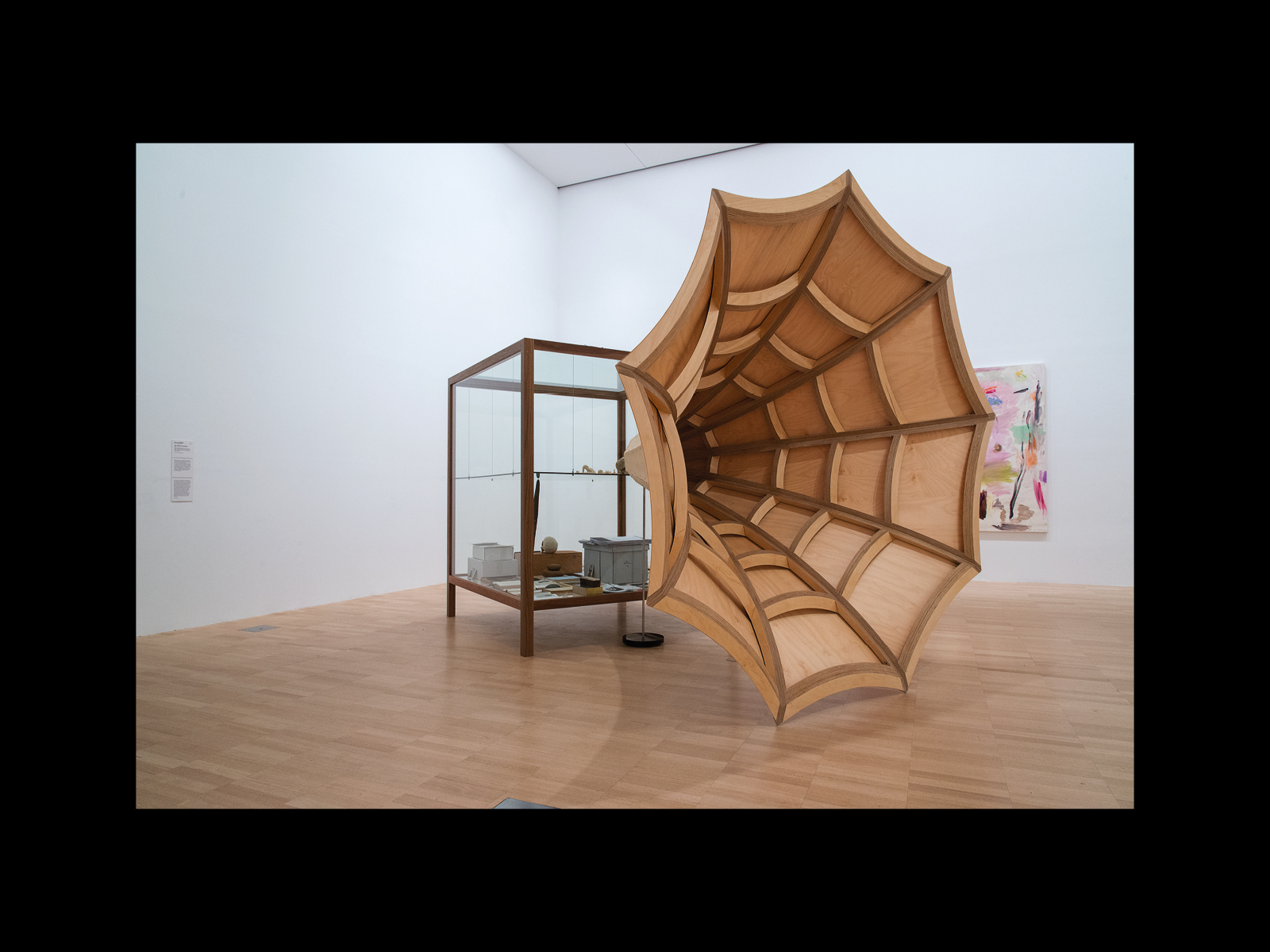
Andrew has stated that the original idea for Vox was to exhibit British-born first Professor of Anatomy at University of Melbourne Richard Berry’s Dioptrographic Tracings of Fifty-Two Tasmanian Crania (1909), made up of fifty-two tracings of the skulls of Tasmanian Aborigines, which Berry had extensively studied as part of his phrenology-inspired project to prove that human intelligence is an effect of the shape of the skull. But Berry also undoubtedly understood his book, insofar as the shape of Aborigines’ skulls were supposedly proof of their lower intelligence, to be a last record of a people who would soon no longer exist and therefore proof that they once did. This is Andrew himself in an artist statement for the work’s first showing, speaking of his justification for exhibiting Berry’s book: “We came to the conclusion that no matter how this book was shown that it would be neither good nor bad for the legacy of what exists in today’s mainstream consciousness or for the trauma that lives on within those who are aware of these histories.”3 But Andrew also concluded that merely exhibiting Berry’s book was not enough and that he needed to add a certain “state of effects”: “With this in mind, I returned to my personal archive of books, postcards and cultural objects, wishing somehow to strike a balance in the presentation of this material between revealing and concealing, which is the artist’s role.”4 Vox then was to take the form of something like a vitrine in a natural history or anthropology museum, which houses a series of objects on two glass shelves: on the upper level, a disarticulated skeleton lying flat on its back with its skull pointing upwards and backwards; and, on the lower level, a photocopy of Berry’s book with its pages removed and lying next to the spine itself like a skeleton, along with a variety of materials that, although all from Andrew’s own private collection, look like they come from a museum or library—a stone axe, a shield, a pair of grinding stones, books by European explorers recording their travels through foreign lands, drawings, photography and films by anthropologists recording Indigenous peoples, and a number of unopened grey boxes containing we presume human or animal remains.
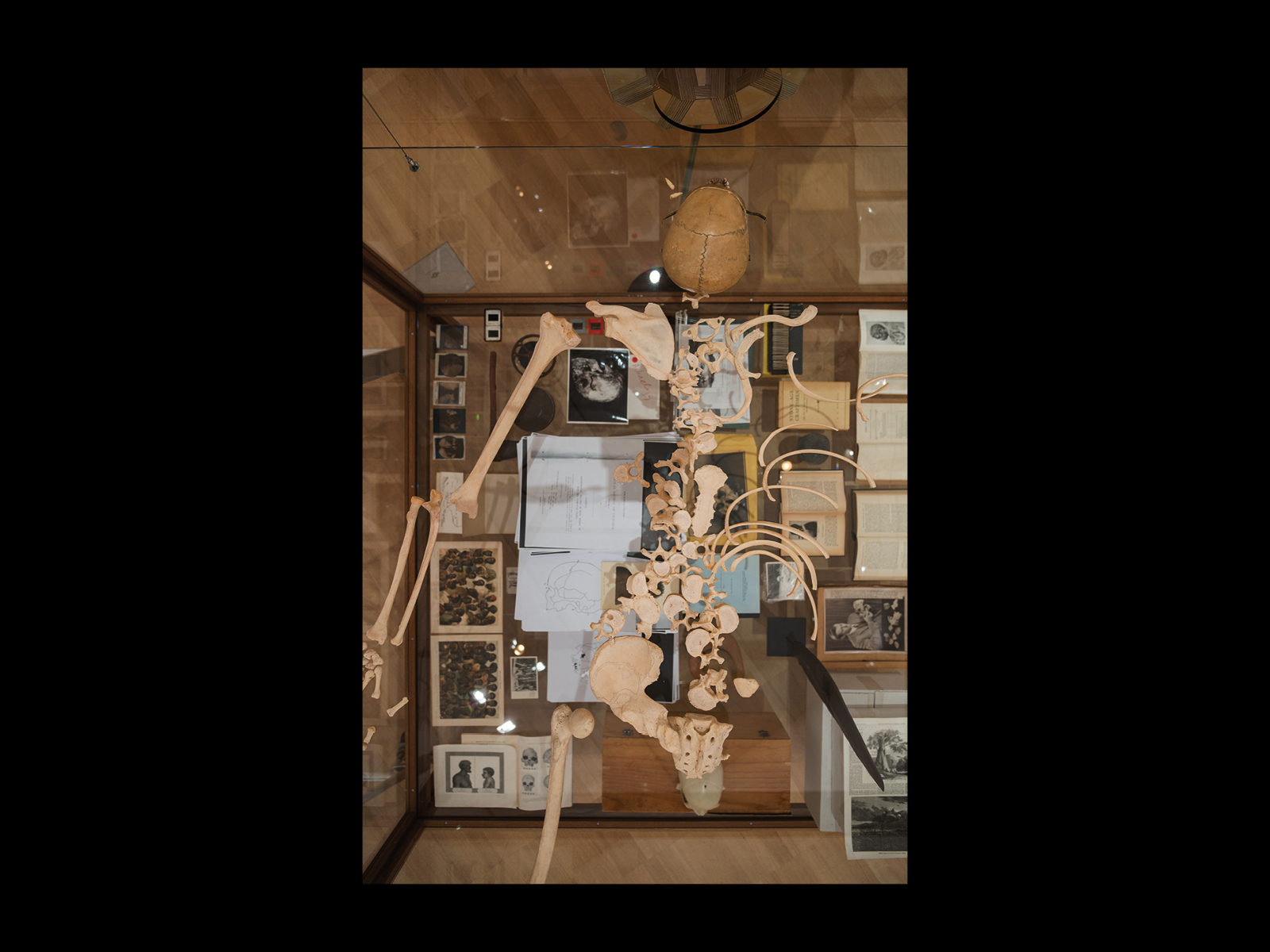
The items on the two levels of the vitrine are not displayed or arranged in a museologically orthodox or conventional way. For example, on the bottom level, we have a series of representations and recordings of a number of Indigenous peoples from around the world (Cape Maria Van Diemen on the North Island of New Zealand, Gabon on the West Coast of Africa, the anthropologist Richard Leakey holding up an Australopithecus skull in Kenya), but without any seeming criteria for which people are represented or the scientific status of the representation. (We have Stone Tools and Camping Places of the Australian Aborigines by S.R. Mitchell, which is a scientific study; but we also have Studies of Savages and Sex by Ernest Crawley, which is obviously a lurid and racially stereotyping book meant for a popular readership). Equally, although many of the items are clearly labelled and displayed (Transactions of the Royal Society of Victoria, Notes from the Bernice Pauahi Bishop Museum), there are also a number that are either leant against boxes or simply unopened, so that what we observe and admire as much as anything is their formal arrangement. Despite the fact that they all apparently come from Andrew’s own personal collection, there are all kinds of different categories of objects included, with some presenting like official anthropological artefacts and recordings (axe, shield, boxes of slides, a reel of film) and others like tourist snapshots or souvenirs. Finally, there is the at once irreconcilable and highly over-determined relationship between Berry’s book on the bottom level of the vitrine and what can only appear to be an actual Aboriginal skeleton (although in fact it is not) on the top. To begin with, this skeleton must strike us as the very object of Berry’s study and the realisation or embodiment of so many of the slides, photographs and recordings on the level below—but within the conventions of contemporary museum practice it is absolutely no longer possible to exhibit actual indigenous remains.5
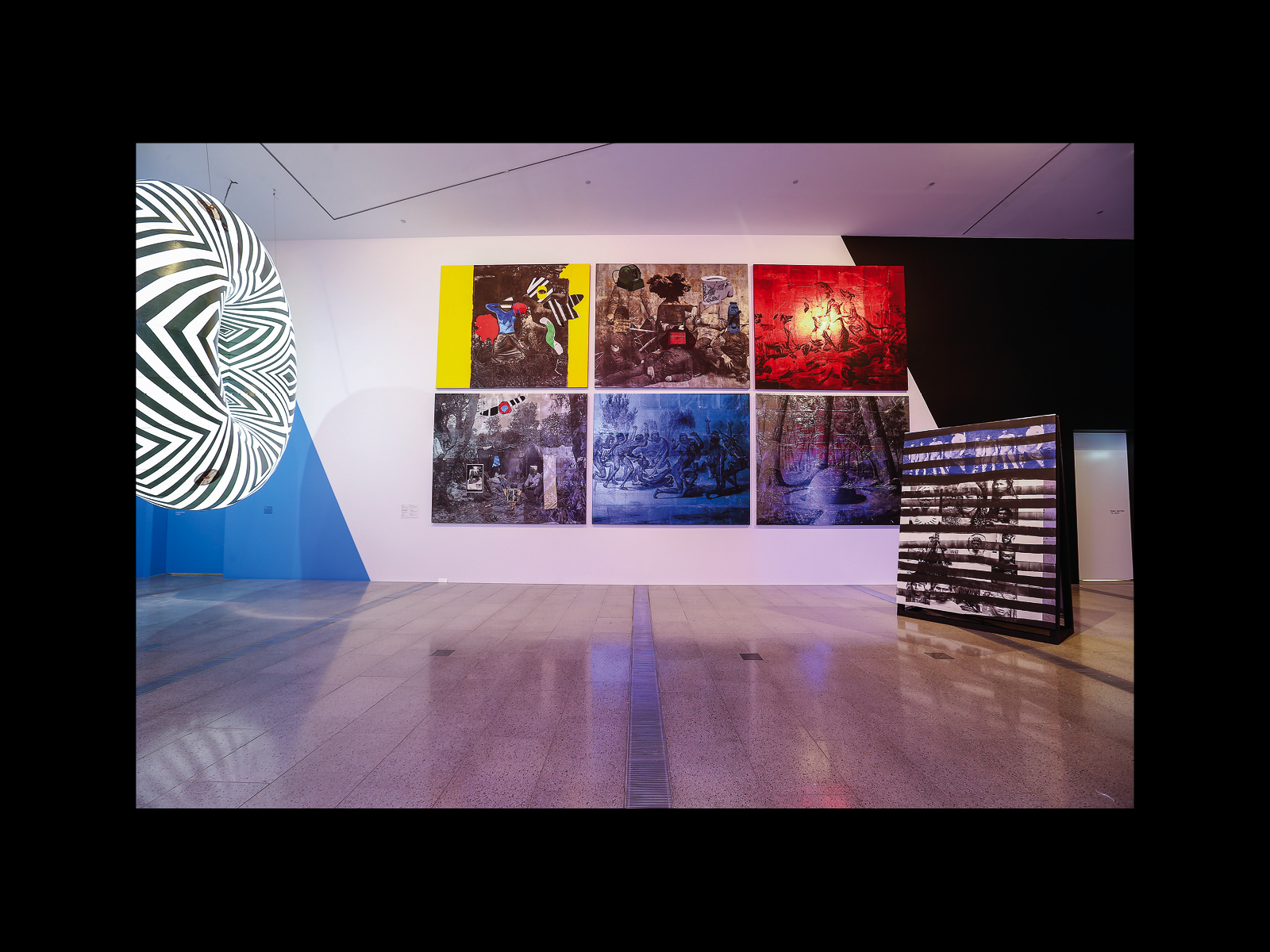
These, then, are the contents of the vitrine or display cabinet that makes up Vox—to which we will return in what follows—but perhaps the most notable element of the work (or at least the one we will take as the initiating moment of our discussion here) is what Andrew has attached to the side of the vitrine. It is a large wooden speaker, some two metres high, suspended by a metal stand that opens up as it reaches out into the gallery, as though it were an old-fashioned gramophone horn, casting the apparent meaning of the work (and particularly the voice of the skull that appears to be speaking into it) out to the audience standing before it. In different installations of Vox this amplifier is presented in different ways. For example, in the original version of the work at Tolarno, it is shown simply hanging to the side of the work in an open room. In Splinter of Monuments: A Solid Memory of the Forgotten Plains of our Trash and Obsessions (2014), exhibited at the Museo Reina Sofía in Madrid, the amplifier seems to reach across to another vitrine of objects next to it. And this difference is reflected in the various photographic representations of Vox in books and catalogues, which bring out different aspects of the loudspeaker's relationship to the rest of the work. In its most orthodox or at least most recognisable form, the speaker is depicted standing clearly to the side of the vitrine in an all-over shot of the gallery. But in other reproductions of the work—for example, in the catalogue for the exhibition The Right to Offend is Sacred at the National Gallery of Victoria in 2017—the spectator is positioned looking down into the very mouth of the gramophone as though it is about to swallow them.
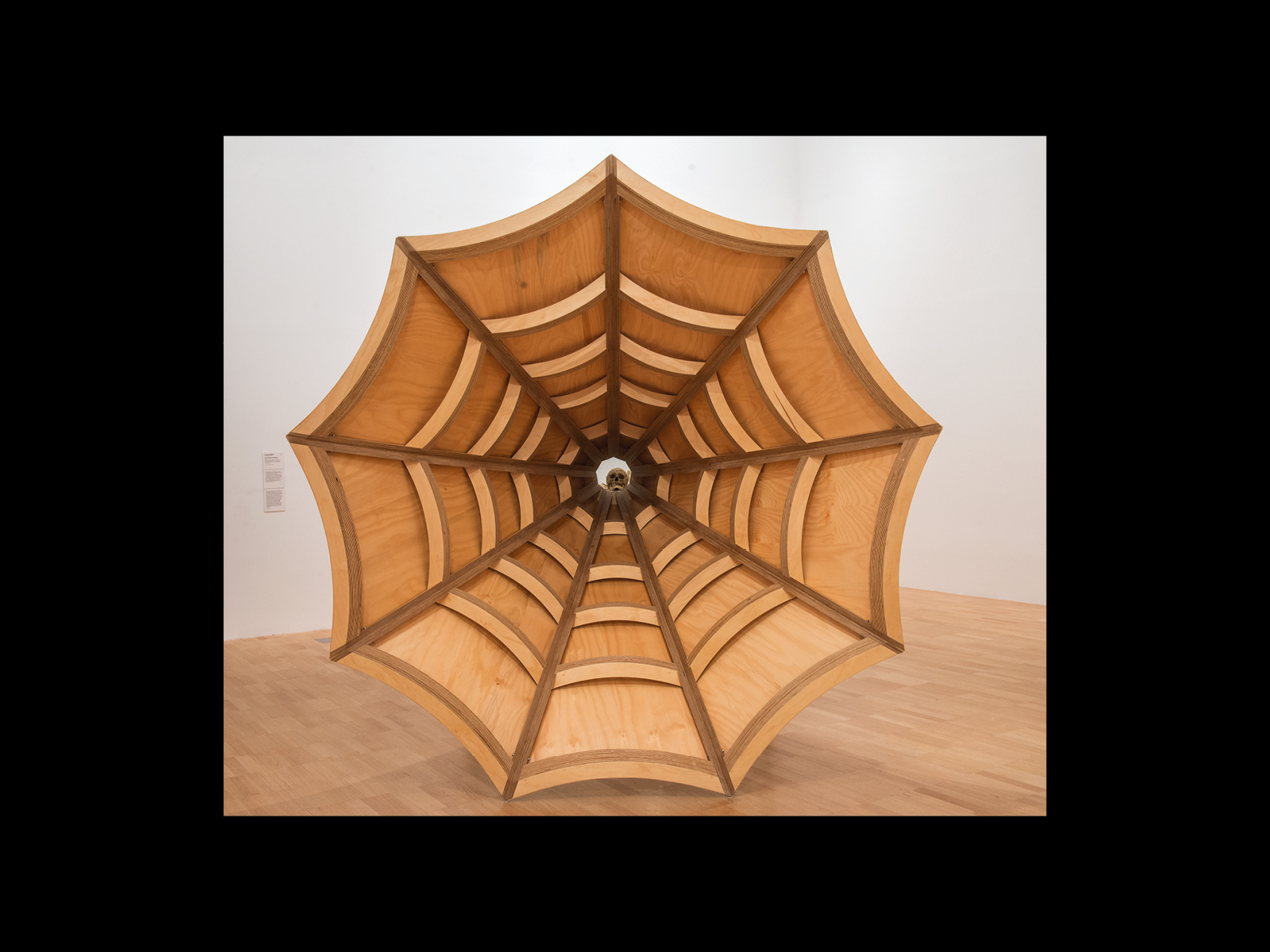
It is this gramophone-like horn that obviously gives Vox its name. The suggestion is, of course, that the work is somehow speaking to us, and this device amplifies what it is saying so that it can be heard, turning something whispered into something declamatory. And it is undoubtedly this, the loudspeaker or megaphone, that is the added element to what could otherwise be understood as a straightforward, if slightly unorthodox, museum exhibit; it is the artist’s specific touch or addition. Beyond his specific choice and arrangement of the objects in the vitrine, the loudspeaker is the sign or signature of Andrew as an artist. More precisely, it is the addition of this horn to the side that makes Vox a work of art. It is what not merely visually or materially, but we might also say conceptually, distinguishes Vox from an exhibit of anthropology; and it is indeed something like this that is to be seen in all works of contemporary Indigenous art (of the kind to be found, for instance, on the upper floor of the Colony exhibition) that might otherwise be mistaken for forms of ethnography or anthropology. Indeed, if we could say that the work on the upper floor of the exhibition sought to make of the colonial art below a form of anthropology, this would be insofar as it was not and instead took this colonial anthropology as their subject as works of art.6
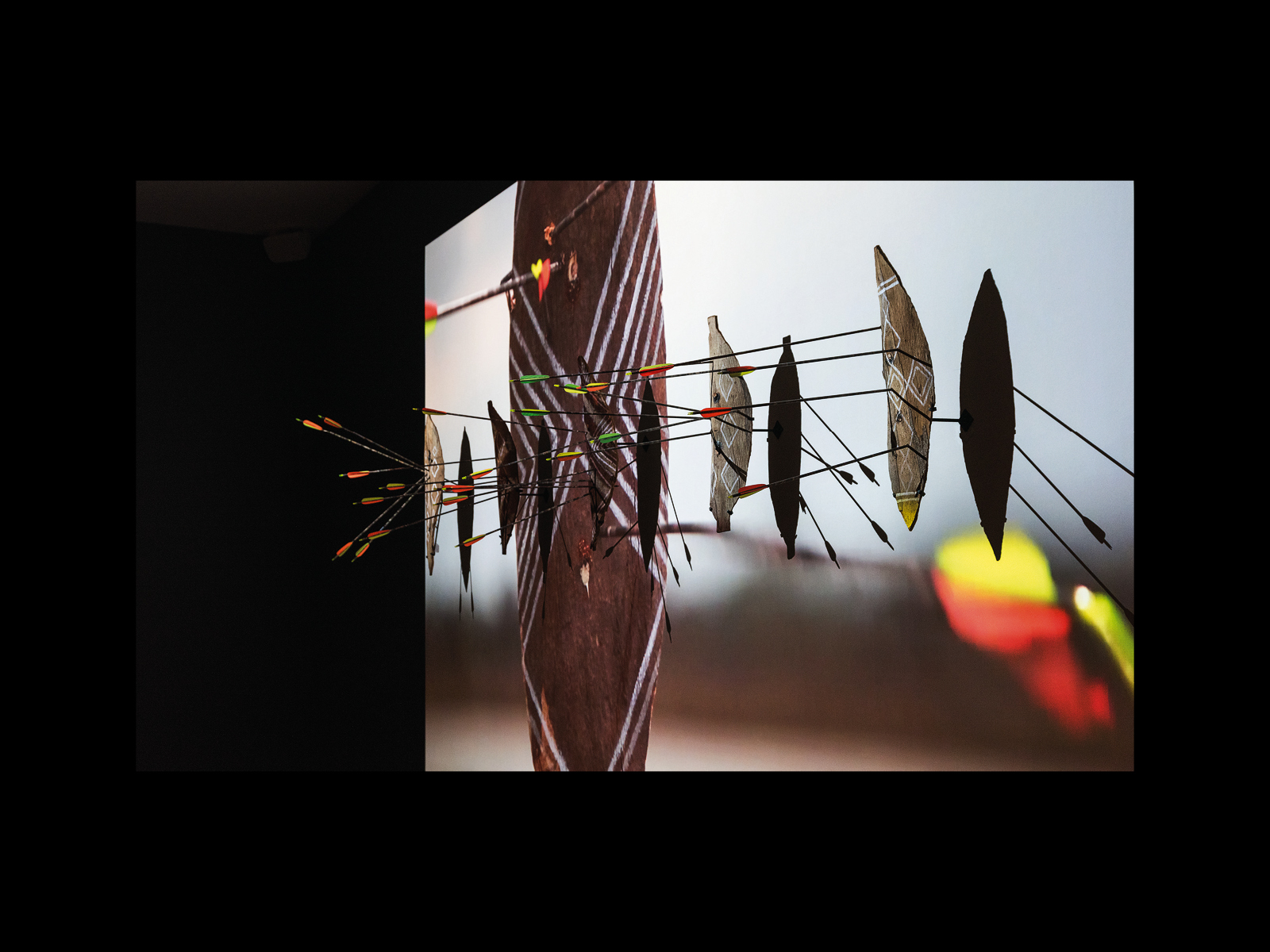
How is this to be seen? What is the difference between art and anthropology in this regard? Or, to put this another way, what does Andrew think he is doing as an artist taking up this anthropological material? How does he imagine remaking or remarking it as his art changes it? In what ways, therefore, are we allowed to think about this anthropological material differently, now that it is presented as a work of art? We attempt to answer these questions largely with regard to Andrew here, but we might begin by looking at the work of a number of the other contemporary Indigenous artists in Colony who re-present anthropological artefacts in a gallery setting. First, there is Christian Thompson’s Othering the Explorer (2015-2016), in which the artist looks through the eyes of a large blown-up photograph of James Cook, held up before his face. Then there is Steaphan Paton’s Cloaked Combat (2013), in which we have arrows fired into a series of Indigenous shields mounted on the wall. And, finally, we have Lorraine Connelly-Northey’s Possum-Skin Cloak (2013), in which a starry night sky made out of barbed wire is surrounded by a variety of hands, feet, and carry bags made out of rusted tin. What would we say is characteristic of all of these works? What method or technique do they all have in common? We would suggest that in all of them there is some kind of indicated distance from their subject matter, almost like inverted commas, which is to point to the fact not so much that the work is appropriated (which it often is) as that what we take to be the subject matter of the work is not its real subject. Or even that it is not so much the subject matter of the work that we meant to engage with as what we might call its form that we are asked to reflect upon. Of course, this aesthetic distance might be true of art itself, but it is perhaps surprising that it is this classical conception that is at stake in contemporary Indigenous art, and moreover that we will always find in this work something operating as the very sign of art itself.
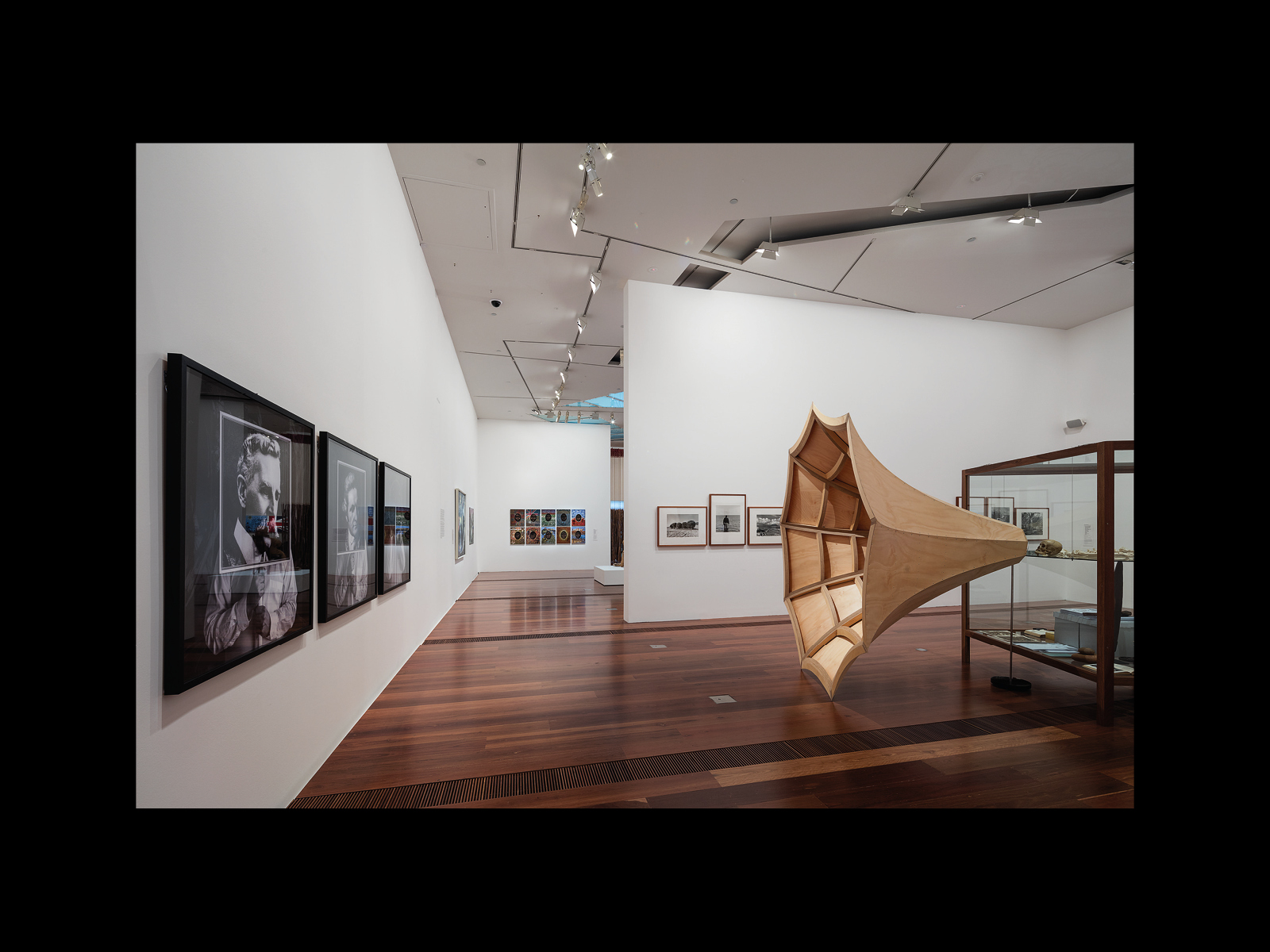
Returning to those three works from Colony we looked at, in Thompson’s Othering the Explorer we have the eyes of the artist looking out through the back of the image; in Paton’s Cloaked Combat we have the arrows pointing to the shields; and in Connelly-Northey’s Possum-Skin Cloak we have the cut-out hands and feet arrayed around the edge of the picture.7 And something like this is to be seen even in those “traditional” Indigenous works in the upstairs section of Colony—for example, the shields, clubs, spears and carrybags from the collection of the National Gallery of Victoria,—installed in the same room as Paton’s Cloaked Combat. They were not mounted on the walls like the works—both colonial and Indigenous—in the downstairs section of the exhibition, but spread out on the ground, holding and balancing each other through hidden supports like the various parts of a modernist sculpture. Again, the exhibit was nothing like a neutral, objective, historically distanced and culturally “respectful” display; on the contrary, it was something intentional, subjective, creative and interventionist. The works no longer simply frame or are framed by the institution like the thirty-four shields that greet the visitor as they enter the first part of the exhibition, but in a complex way frame themselves. Similarly, as many of the Indigenous objects as possible are no longer labelled “unknown”, as still largely is the case in anthropological museums, but the group of makers sought to be identified (and, if not the actual makers, at least the specific region of Australia from where they come). This is not merely a matter of social justice but more a claim that these works have actually been created by somebody, as though there were a certain identity behind it. In both cases, when we look at the work, we are engaging with another subjectivity: first, the one who made the object, and then those who used (and sometimes died with) it. This goes toward what we take to be the desired or intended audience response to the work: not empirical, historical, scientific, with a clear and measurable outcome, but intimate, engaged, reflective, whose ultimate aim or justification is yet to be determined.
Something like this “framing” is also to be seen in Andrew’s work, even before Colony. Indeed, this aesthetic remaking or remarking of anthropological or ethnographic objects is one of the longest-running and most deeply motivated threads of his practice. Perhaps the first clear instance of it is Sexy & Dangerous (1996), originally shown at the Ian Potter Gallery at the University of Melbourne, in which he enlarged a portrait by the nineteenth-century photographer Charles Kerry of an unidentified Djabugay man from North Queensland in feathered headdress, to which he adds the words “Sexy and Dangerous,” first in Chinese characters and then English. We might think then of Andrew’s installation Menthen . . . Queue Here! (1999), originally exhibited at the Djamu Gallery in Sydney, which consisted of a hundred Aboriginal shields from the vaults of the Australian Museum in Sydney, arranged back to back in two long lines with yellow and black emergency barriers immediately in front of them and on either side blocking the viewer’s immediate access. We might recall as well Andrew's large exhibition Theme Park (2008) at the Museum of Aboriginal Art in Utrecht, which consisted of an enormous variety of both ethnographic and non-ethnographic objects,8 at once packed and unpacked (the exhibition included a section entitled “Corridors and Boxes,” which largely depicted the contents of the museum’s storage facility still on its shelves), along with Andrew’s signature black-and-white inflatables decorated in traditional Wiradjuri dendroglyphic style. Finally, we might speak of Sanctuary: Tomb of the Outcasts (2015), also at the Potter Museum, which featured a wide variety of items on the walls and in the rooms of the gallery (a historical photo of a Indigenous police officer on his horse, the Rogers and Hammerstein album South Pacific next to a newspaper featuring a headline about Australia’s offshore detention policy, books detailing the colonial history of Australia in a pile on the floor). This work also included, like Vox, two purpose-built vitrines, one holding a brass breastplate bearing the words “King Charles of Snowy River 1866,” the other containing, amongst other things, photos of Australian soldiers during World War I, a dugong foetus, an ancient Greek vase, and a letter from the Shell Oil company concerning the proposed hiring of an “enemy alien” then detained in an internment camp during World War II.
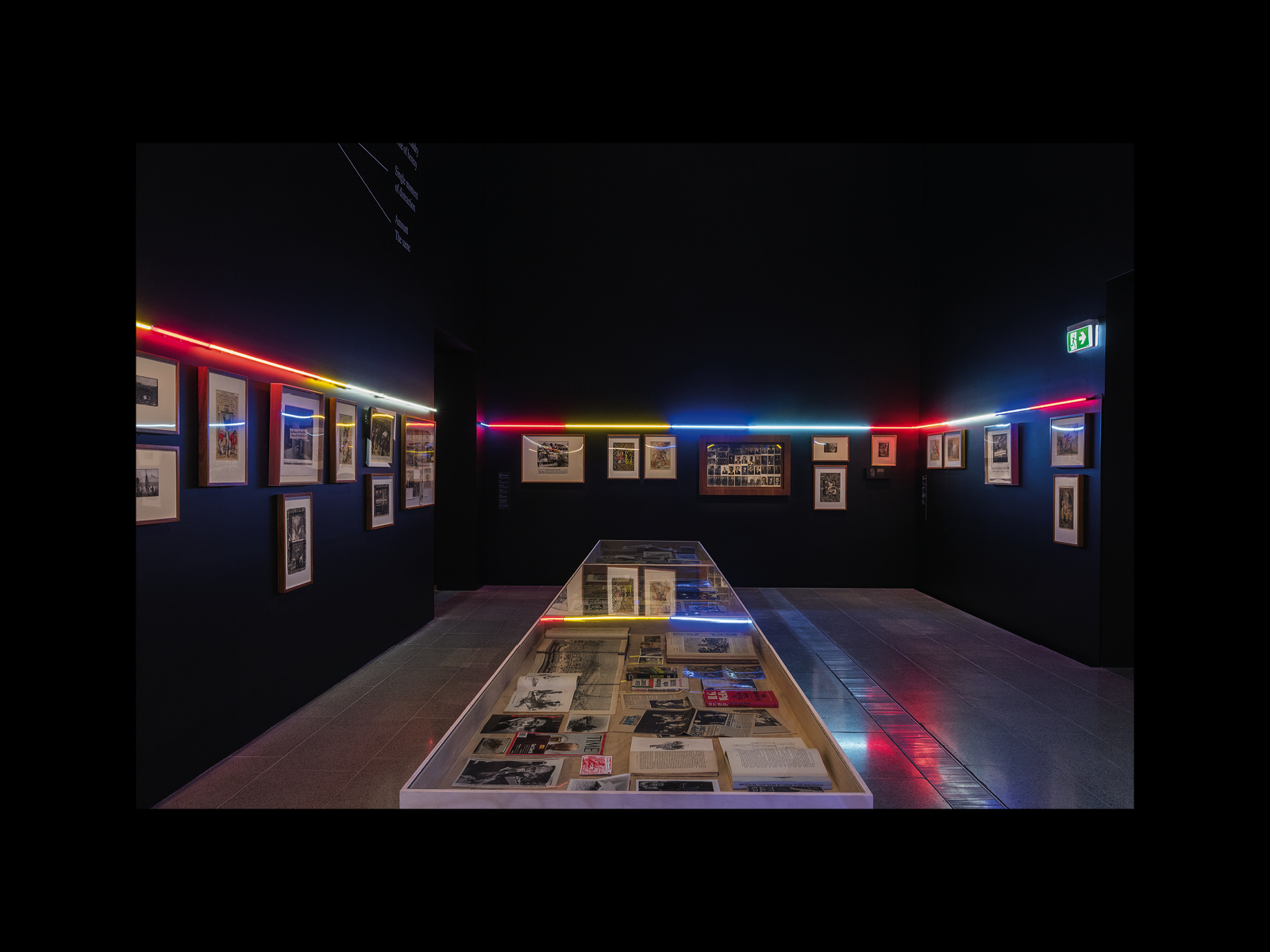
The question raised in all of this is: What does Andrew seek to accomplish by taking this historical and anthropological material and presenting it in a museum context like this, and moreover in the form of an artwork made by a particular artist in the present? In some way, of course, it must be considered as an excuse for presenting social-historical material to a new audience in a straightforward act of cultural advocacy. But, more than this, certain powers are attributed to this act of “aestheticisation.” Of course, at first all of this can be aligned to a more general “archival” impulse in contemporary art, first noted by critics like Hal Foster more than two decades ago with regard to such artists as the Swiss Thomas Hirschhorn, the English Tacita Dean and the American Sam Durant. For Foster, this interest in the historical archive must be understood as manifesting “a will to connect what cannot be connected, not so much as a will to totalise as a will to relate.”9 And, as noted by subsequent commentators, this original “impulse” has been picked up by any number of Indigenous artists from around the world, such as Canadian Carl Beam with his collages mixing historical colonial images and pop culture, the Kenyan Miriam Syonia Kyambi and her reorganising of the holdings of the Kenyan National Museum and the Native American Hulleah Tsinhnahjinnie and her reclaiming of anonymous photos of Native Americans depicting them as a “vanishing race.” The aim behind such “reclamation” projects in the words of Ferdinand de Jong, the editor of a special issue of World Art on the subject, is to “conceptualise the hidden histories and counter-memories . . . whose traumatic contents need to be addressed to open up alternative futures.”10 And this impulse, as Australian commentators have pointed out, has been followed by any number of Indigenous artists here. Take, for instance, Khadija von Zinnenburg Carroll on what she calls the Indigenous “anachronic archive”: “In urban Indigenous art geared to post-colonial themes in particular, the genre may be seen to be dominant to the point of being hegemonic, as if a post-colonial future cannot be imagined without first dismantling the colonial archive.”11
Now we might think of Vox in the light of these remarks, considering how it is consistent with those other works, and how it extends or even breaks with them. To return once more to the material contents of the vitrine, what we have is neither a straightforward anthropological presentation, nor a surrealist juxtaposition, nor even an obvious refusal or parody of museum protocol.12 We have on the bottom level of the vitrine a wide assortment of ethnographic objects, images, writings, film and photographic recordings. At the centre of the vitrine, on top of an unopened archival box, is the photocopied version of Berry’s book, sitting above all of the other objects as though they serve as empirical evidence for its generalisations. Below it, but nevertheless still sitting on boxes, are a Dharug stone axe from Emu Plains, New South Wales, a photo of a tree incised with Wiradjuri markings and a small plastic skull facing out the back of the vitrine. On the bottom level, resting on the glass are a series of drawings and photographs of Aboriginal skulls, a box of slides and thick glass lantern slides laid out next to it, a reel of film, and as though to prove that Berry’s project was not alone, two books by the Director of the Anthropology Museum at the University of Sydney, S.L. Larnach’s Australian Aboriginal Craniology and The Craniology of the Aborigines of Coastal New South Wales. There is a Wiradjuri parrying shield that points upward like an extended finger or an angel’s wing, two colour lithographs at one corner of the vitrine, Ozeanische Völker and Afrikanische Völker, dried emu feathers that look like skeletons and a selection of Andrew’s tourist postcards depicting Indigenous peoples from around the world. Finally, on the upper level of the vitrine, which is held aloft by a series of wires, there is the skeleton on its back with its skull flipped over and up, and seemingly speaking into the gramophone horn to the side. The skeleton lies—or we might even say floats—directly above Berry’s book, implying some sort of relationship between them. If its height above the lower level can evoke a certain transcendence of the material, is this not to suggest a refutation of the fate Berry predicted for Aboriginal people, a kind of living on or immortality? Or is it, on the contrary, the fulfilment of Berry's prediction (and that of other books in the lower half of the vitrine) that Aboriginal people will soon all be as the skeleton collected and studied here?
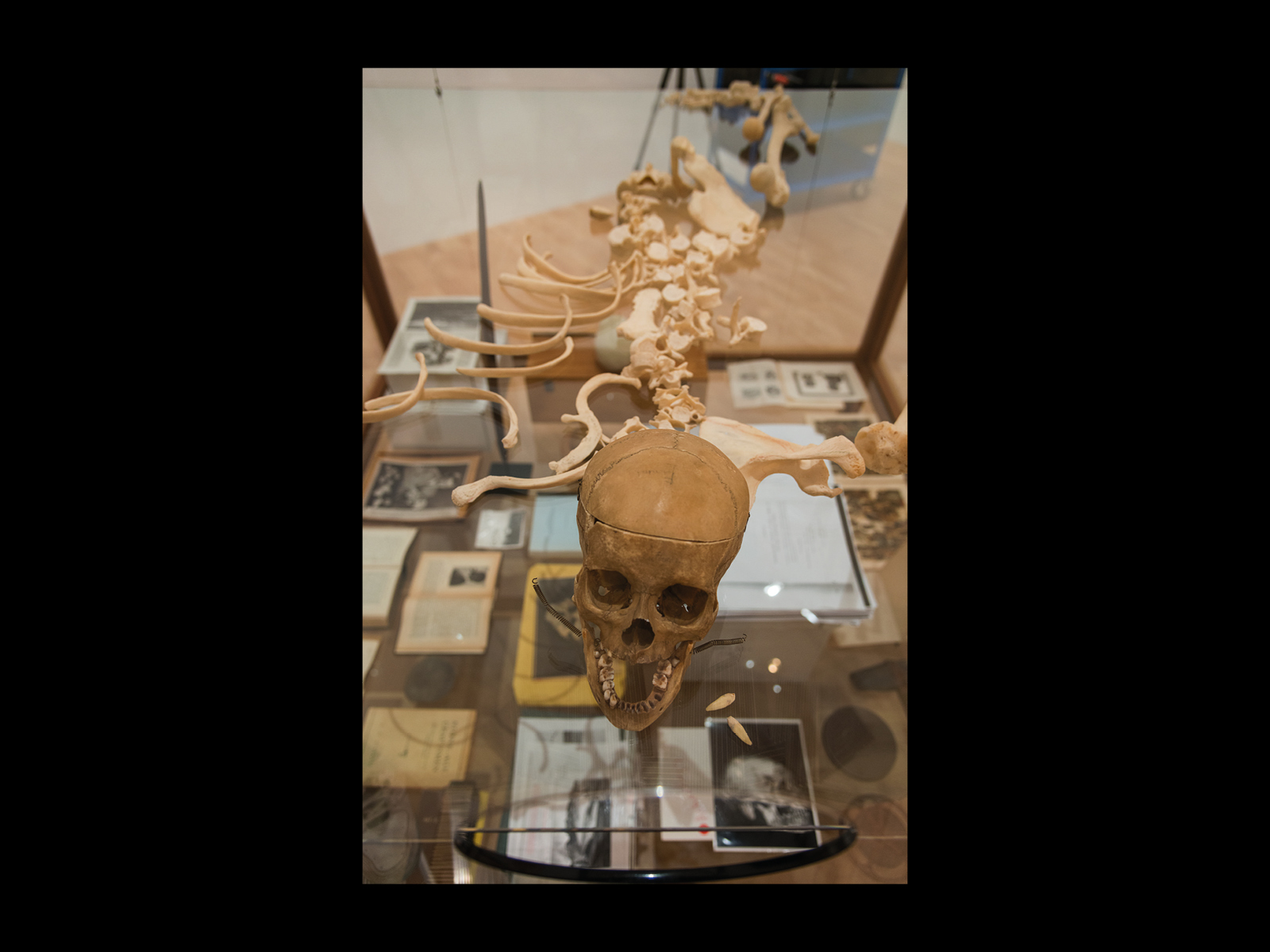
All of this is undoubtedly complicated by the fact that it is Andrew who exhibits what we take to be an example of those real Aboriginal skeletons studied by Berry and Larnach. In fact, Andrew obtained the skeleton from the sister of a friend studying anatomy in medicine. But in the context of the vitrine, it is undoubtedly meant to be understood as Aboriginal. Of course, in doing so, Andrew thereby risks censure for exhibiting the remains of Indigenous people in museums, which is no longer ethically or museologically possible—and particularly so insofar as Andrew is an Indigenous man himself. To be especially considered here—particularly in the light of that “universality” that we later claim is at stake in Andrew’s work—is what seeing this skeleton might mean for Indigenous people looking at the work, and how its display would be seen as a breach of cultural protocols that are particularly important. And we suspect that this notionally Indigenous skeleton merely raises, in more acute form, what is at stake with all of the taking of Indigenous images and recording of Indigenous voices that is to be seen in the rest of the display. However, it is also to think that it is only thanks to colonial anthropologists and ethnographers that there is any record, at least of the kind to be found in textbooks and museums, of past Aboriginal culture. On the one hand, if there is the unauthorised reproduction and even appropriation of Indigenous culture and remains, then on the other hand, this also perhaps allows a space to speak from, the evidence of a people in whose name one can speak.13 (And this is particularly the case for a number of Indigenous artists like Andrew, who are no longer directly connected to tradition, and whose access to their Indigeneity is at least in part through these anthropological records and other kinds of archival materials.)14
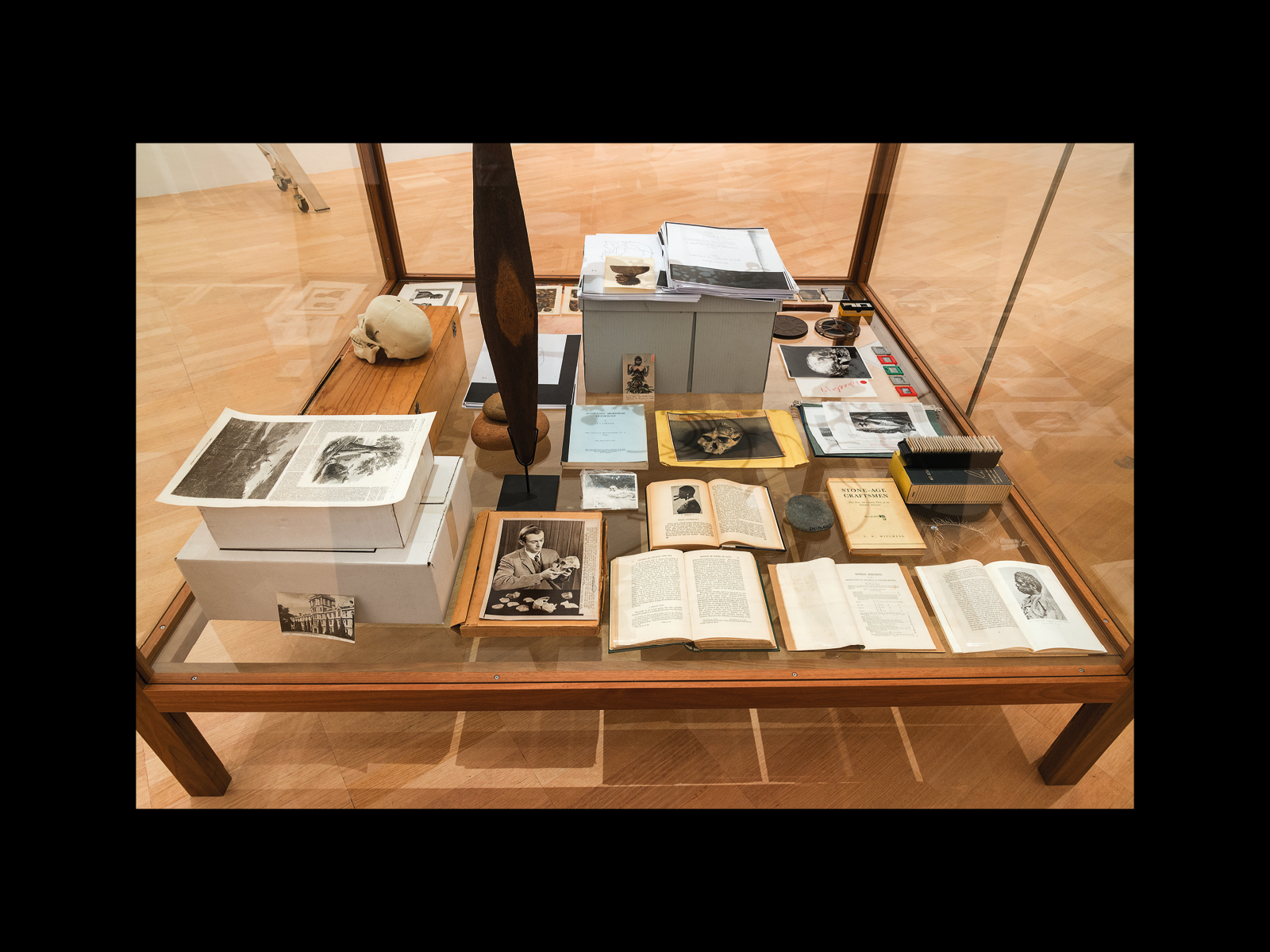
It is this kind of self-contradiction that marks Andrew’s entire practice (and that whole strand of contemporary Indigenous art of which it is part, even if it does not employ objects taken from Indigenous people). That is, if on the one hand this art seeks to express the tragedy and injustice of the European settlement of Australia through the rewriting of history from an Indigenous perspective, then on the other it is only able to do this by using the very same colonial archive—and arguably even the same colonial appropriation of Indigenous remains, artefacts and images—that it condemns. We see this contradiction not only in Vox, but also in such other works and exhibitions as 52 Portraits (2013), which draws on the German naturalist William Blandowski’s Australien in 142 Photographischen Abbildungen (1862); Menthen, which draws on the holdings of the Australian Museum in Sydney; and Splinters of Monuments: A Solid Memory of the Forgotten Plains of our Trash and Obsessions (2015), which draws on the holdings of the Museo Reina Sophía in Madrid. It is a contradiction that is acknowledged by Andrew in the following terms: “Creating order from my own understanding of the chaos of my living years as an artist in a colonised country, I have not a clue how to work with the mass of conflicting stresses today.”15 It is also something spoken of by a number of Andrew’s commentators, for example academic Jessica Neath, who thinks his work as a form of “legacy image”: “The term ‘legacy image’ connects this photographic material to the continuing effects of dispossession and considers these photographs as powerful evidence, but also as objects of memory and connection to ancestors.”16 But this can take an even more pointed form when the artist is criticised for not seeking adequately to identify the particular individuals or tribal groups whose work he reproduces, or, where they can be identified, not doing enough to consult and obtain permission to use the material in question. Curator Djon Mundine, for example, writes on Andrew’s photographs involving unidentified Indigenous figures: “Isn’t Andrew like the colonial gentleman on a grand tour of museums? He appears to distance himself and his use of images completely from the Aboriginal society of their origin.”17 Yet at the same time it has also been argued that what Andrew’s practice demonstrates is that the archives were only holding this evidence until the proper time arose for its respective Indigenous owners to know how to make proper use of it. As Andrew records Indigenous expert on repatriation protocols Maxine Briggs in his 2017 Interview series: “Information was handed on to the white authorities so that it would be there for us when we were ready . . . that information is now the foundation of our identity and it’s helping us rebuild our connection to Country.”18
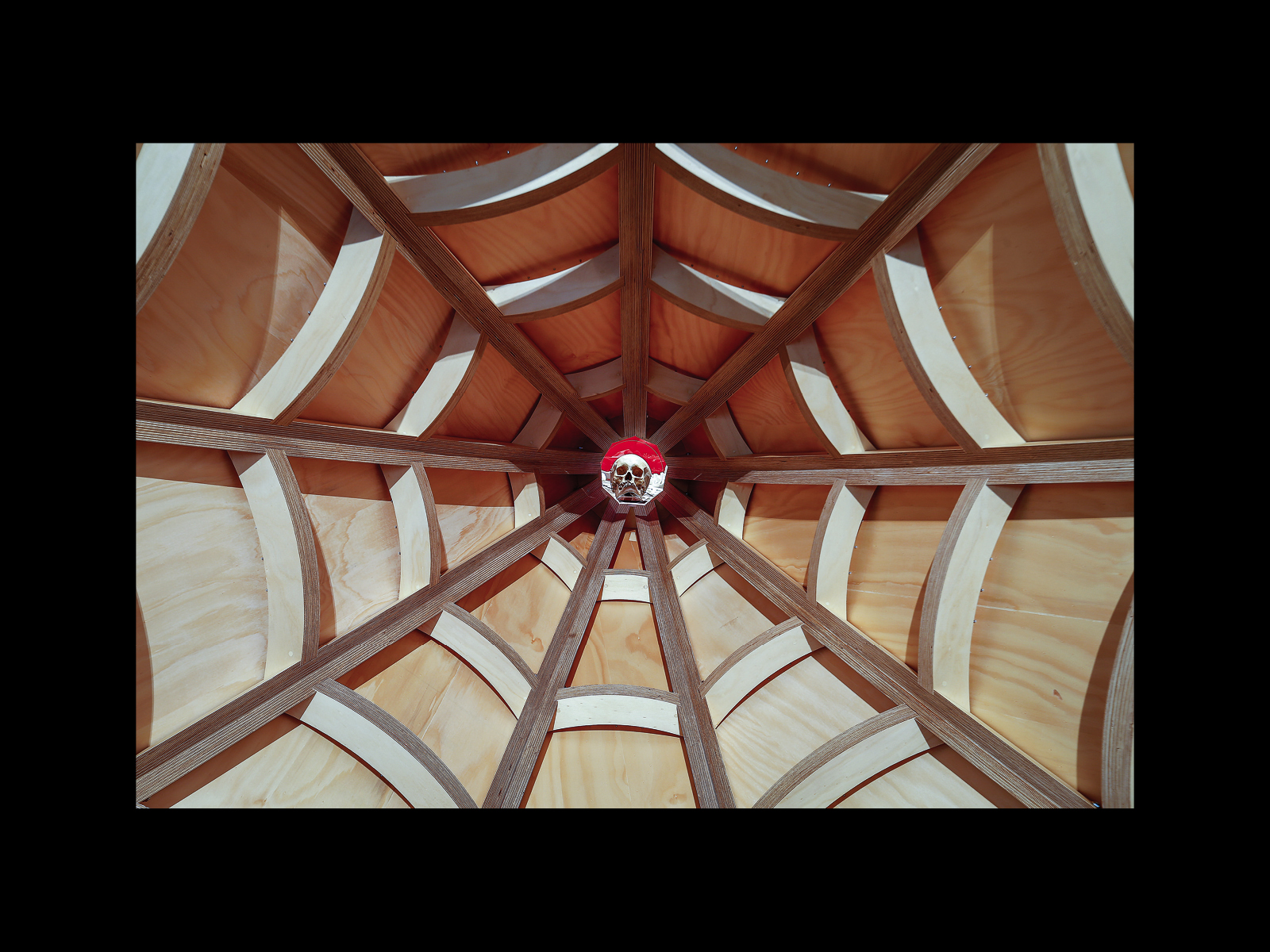
Now again how might all of this be thought in terms of Vox’s declared status as art and not anthropology? Specifically, how might the work’s limits or even self-contradictions—which are precisely of the kind that anthropology seeks to resolve to the extent possible—to be understood in terms of its status as art and not anthropology? It is at this point that we come back to that feature of Vox we have not yet properly considered and that we suggest is what distinguishes it from anthropology: that gramophone or sounding horn attached to the side of the glass vitrine. If we can imagine Andrew’s vitrine by itself in an anthropological museum, it is with this loudspeaker attached to its side that we cannot.19 In other words, the horn is the very sign that Andrew’s work is art, in some way equivalent to the artist’s signature, that which distinguishes art from other similar objects in the museum. It creates a frame around the vitrine, distinguishes it from the usual museum display, bracketing or suspending it, so that the vitrine is not what it appears to be. (And in this regard, it is notable that this horn is supported off the ground, just like those objects in the glass vitrine.) Perhaps, we will come to suggest, this horn is even something like what the French deconstructionist philosopher Jacques Derrida calls a “parergon,” which “comes against, beside, and in addition to the ergon, the work done, but it does not fall to one side, it touches and cooperates within the operation, from a certain outside.”20
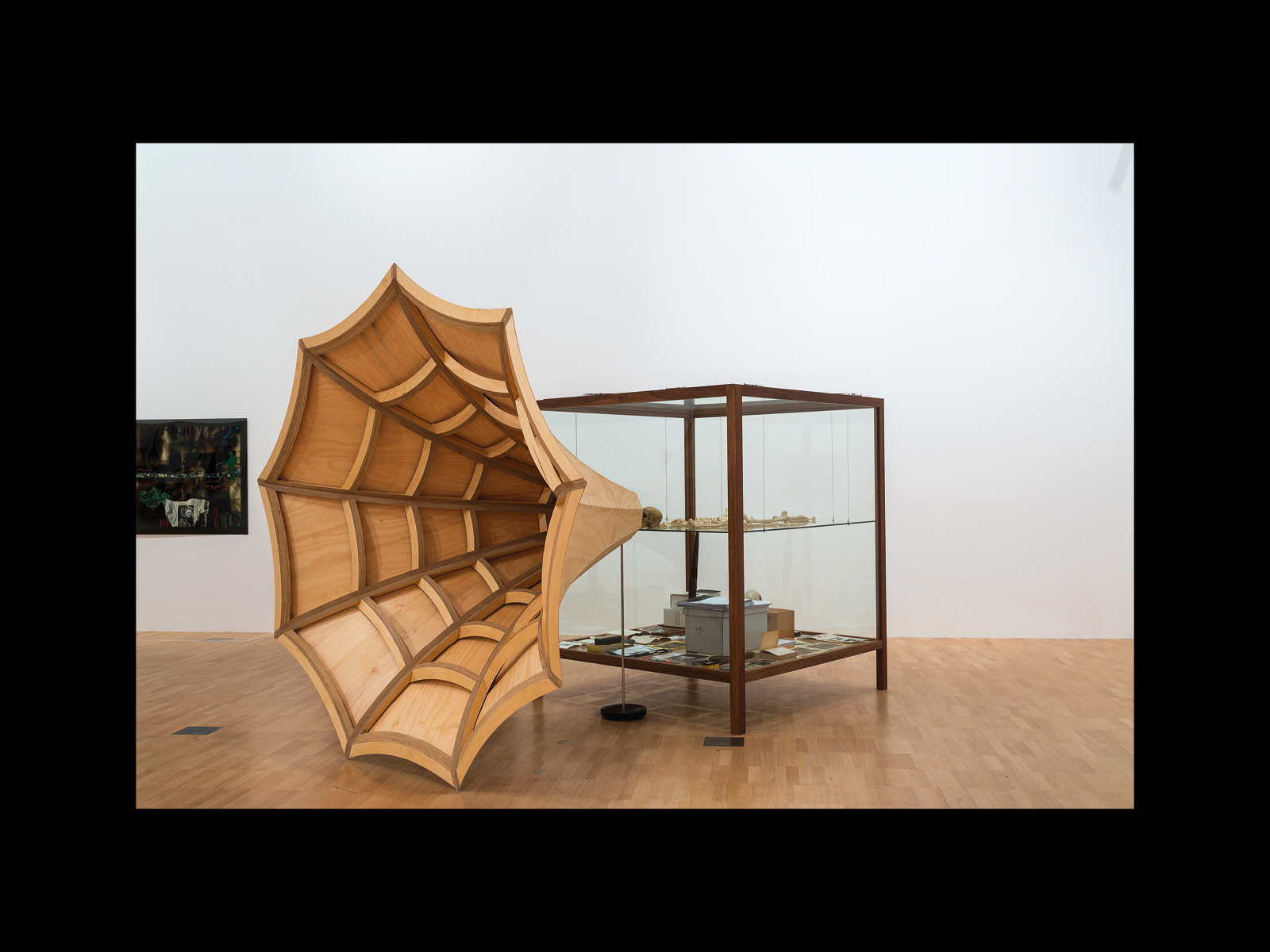
But, first of all, in a little more detail, what actually is this horn or speaker? It rises up the side of the work like an old-fashioned phonograph or gramophone, amplifying the work’s original message. It takes what happens inside the vitrine out into the world, making its secret public. It has the implication of transforming what would be inexplicable, contradictory and even forbidden within the vitrine into a form of publicly accessible discourse. It would be as though it amplifies the vitrine in the sense of making it clearer, less ambiguous, straightening it out. (And this is brought out in the series of installation shots of the work that feature the skull in the top level of the vitrine at the end of the speaker as if it were staring at us or speaking directly to us.) But we also cannot but feel—and this is the real twist this essay turns on—that this amplifier is something of a hearing aid for the work itself, in order that it might somehow cup its hand to its ear to catch what we are saying to it. It would be as though it is not only or not so much its whispering to us that we are trying to catch, but our whispering to it that it is trying to catch.21 As a result, the work would be an expression of or equivalent to what it hears and what we say to it. Indeed, the work might be seen as something of a confessional, a place to which we can come and admit our sins or have someone or something listen to us. It is almost as if—for all of the diminution at the end of the horn—it somehow listens to and amplifies our secret hopes and desires, as though they are somehow squeezed through the confinement of the speaker and then expanded out to take the form of the material we see before us in the vitrine, with its shiny reflective glass surfaces a reflection of us, perhaps blinding us to the work itself.22
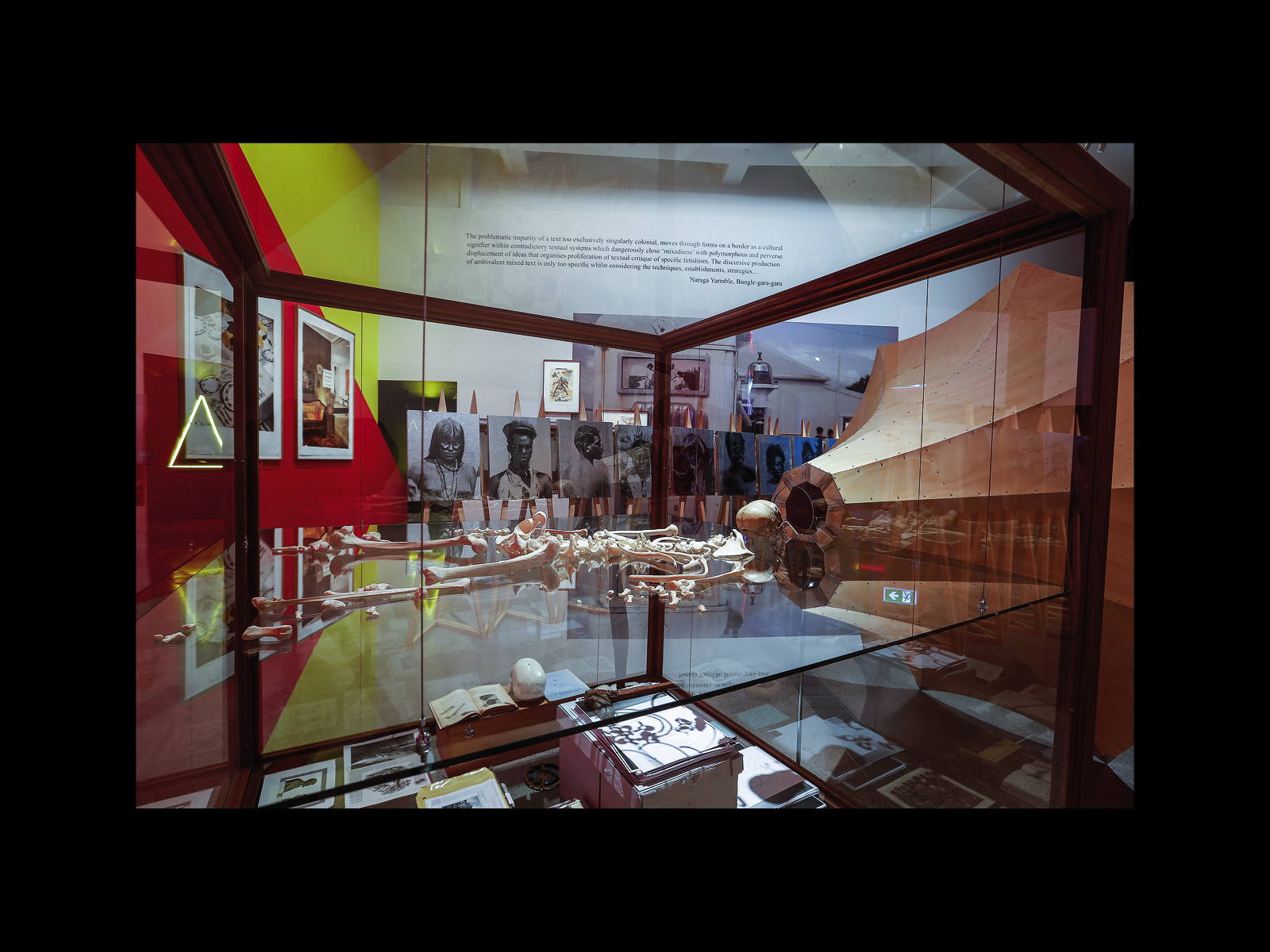
In an uncanny way, what Andrew proposes—or what we propose of Andrew—is a kind of dialogue between the work and us through the horn attachment on the side. The work speaks to us as we speak to the work. Or, we might even say, we speak to ourselves through the medium of the work. That is, when we engage with the work, we are in effect listening to what we say about it; or to put this another way, what the work allows us to do is to listen to ourselves. And it is this again that makes Andrew’s work art and not the anthropological exhibit it might otherwise resemble. However, if the experience is thereby subjective and not objective—and this is the other side of the work talking to us—it implies a subjectivity that is not merely singular, autonomous, individual and able to interpret the work in any way it likes, but responsive, responsible and troubled by the thought that it has not yet got the work right, not grasped all there is to be learnt from it. If we can only see ourselves reflected there, if we can only learn what we already know, then it is also a subjectivity that can grasp itself only through its encounter with the work. To put it otherwise, we can only learn what we already know through looking at the work. The work is ultimately not so much self-reflexive—where what we see is ourselves reflected there—as what enables this self-reflection. If it is something like a mirror, it is even more like the back or tain of a mirror, that which our own reflection takes the place of and can never be seen, but which makes us look as though there were something there before us. (And here we come back to that image of the skull seen through the end of the sounding horn, carrying with it perhaps something of an association with that famous anamorphic skull in Holbein’s The Ambassadors (1533), which sees us but cannot itself be seen.)
Of course, when we speak of Vox like this it cannot but sound—and this is undoubtedly unexpected—like Immanuel Kant’s conception of the “aesthetic” in his Critique of Judgement. Kant begins there, as is well known, by making a distinction between the “agreeable” and the “beautiful” (§§ 1-3). What is not so well recognised is that he also makes a distinction between beauty and anything simply “subjective” (§§6-8). This is Kant in the Critique of Judgement: “As regards the agreeable therefore the fundamental proposition is valid, everyone has their own taste. The case is quite different with the beautiful. For he must not call it the beautiful if it pleases merely himself.”23 However, what is judged in aesthetic judgement is not so much the content of the work as its “form” or “finality,” (§14), and it involves a subjectivity, but a subjectivity that can be known—even to itself—only through the “agreement” of others (§8). Aesthetic judgement is not merely our own individual subjective opinion or preference; it is not possible even from the beginning if it is not understood that others would agree with it, that it is in principle “universalisable” (§6). This is Kant once more in the Critique of Judgement:
The beautiful must be grounded on what he can presuppose in every other man. Consequently, he must believe that he has reason for attributing a similar satisfaction to everyone. He will therefore speak of the beautiful as if the beautiful were a characteristic of the object and the judgement logical, although it is only aesthetic and involves merely a reference to the representation of the object to the subject.”24
And this is to say that in any aesthetic engagement with a work of art we necessarily “communicate” (§9) with ourselves, but only through the implied agreement of others. That is, if aesthetic judgement is over before it begins insofar as the work is merely a reflection of us and we necessarily assume the agreement of others, it is also never complete insofar as it is only through this work and the agreement of others that this self-equivalence is produced.
Amongst the over two centuries of philosophical responses to Kant’s Critique, we select just one here: Jacques Derrida’s “Parergon,” now included in his The Truth in Painting. In his essay, Derrida begins by remarking upon the ambiguity of the notion of “frame” or “ornament” in Kant’s discourse, insofar as we cannot ultimately decide whether it is part of the picture to be judged or remains outside of it. As Derrida writes of the undecidable status of the frame in Kant’s aesthetic theory: “Does it take place [and where?] in relation to the work? On the edge? Over the edge? On the internal border? Or between that which is framed and that which is framing in the frame?”25 But this impossibility of ascertaining whether the frame belongs to the painting or not for Derrida stands in for the impossibility of being able to decide what belongs to aesthetic experience altogether. What is left out or excluded—the outside world, the content of the work, the particularity of the spectator—is unable to be excluded definitively and inevitably returns in one form or another. Again, as Derrida writes: “Without this entirely-other, there would be no universality, no requirement to universality, but for the same reason, with respect to the entirely-other, there is no enjoyment [singular, empirical, existent, interested] or determinant or knowledge concept.”26 But this, consistent with Derrida’s “deconstructive” strategy, must be understood very precisely. It is not simply that Kant can draw no frame between art and life or that he cannot even attempt to. It is rather that the very thing that frames the work of art, closing it off from the outside, also unframes the work of art, opening it up to the outside, rendering the act of aesthetic framing both necessary and impossible. This is Derrida for the last time here: “This lack, which cannot be determined, localised, situated, arrested inside or outside before the framing, is simultaneously … both product and production of the frame.”27
We return one last time to Andrew’s Vox and what makes it a work of art rather than an exhibit of anthropology. This is perhaps to ask, at least from the point of view of the long tradition of aesthetics taking off from Kant: what makes it a matter of disinterest rather than interest, of the universal rather than the particular? But to sharpen the question in contemporary Australia, this might even be put as follows: what makes it a work for everyone rather than either white or Indigenous Australians? Or even—it perhaps comes down to the same thing—what would authorise Andrew’s use in Vox of actual Aboriginal remains, thus breaking all existing tribal or customary laws? And the answer to all of these questions, following Derrida’s suggestion, is the “frame”: that horn-like object hanging off the side of the work, distinguishing it from both conventional exhibitions of anthropology and directly political arguments concerning colonialisation and the resulting injustice to Indigenous peoples. However, again, what exactly in this horn allows or enables this? To begin with, it amplifies what the work is saying to us. And, in another way, it can also be seen to channel like a funnel or hearing aid what we say to it.28 In a strange fashion, therefore—and this is one way of understanding its enigma, unreadability, perhaps even its refusal to scold or preach—what we do when we engage with Andrew’s work is effectively listen to ourselves, open ourselves up to the whispering in our hearts.29 Looking at the work is like eavesdropping on our conscience, which is also to say that we will learn from it only what we already know: if we are troubled by Indigenous injustice, we will see Indigenous injustice; if we are not troubled by Indigenous injustice, we will not see Indigenous injustice.
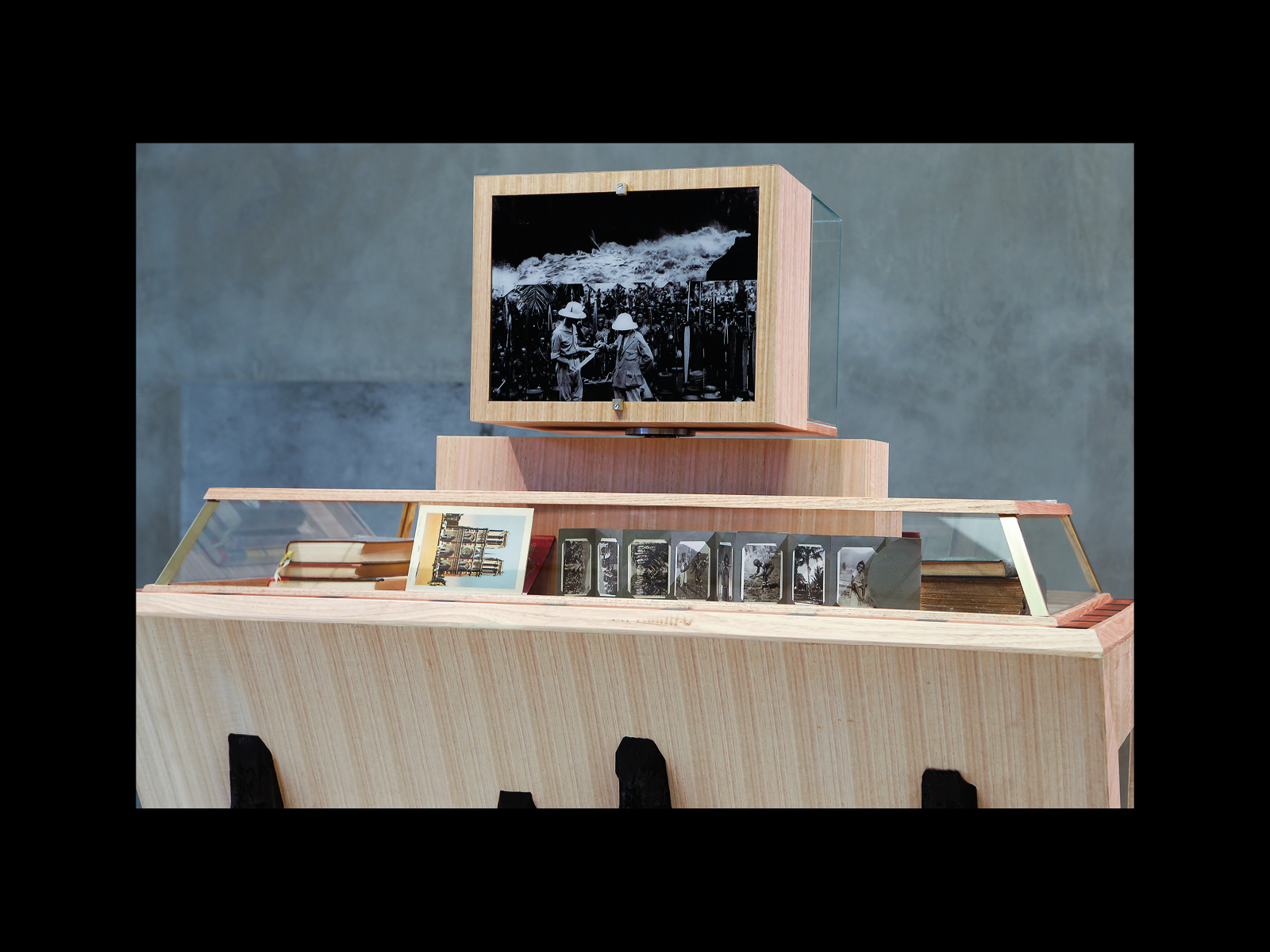
But, to come back to Derrida’s point, with this self-reflexiveness in which through the action of the frame “I return what I take and receive what I return,”30 what is excluded is never entirely excluded. The anthropological fact remains, not as something material—for in the Kantian conception of art there is nothing material—but as that which through its exclusion allows this sublimation or aestheticisation. It is not in the case of Vox a matter of some real, essential Aboriginality—as Aboriginality in art is always shared, universalised, de-essentialised—but that in the name of which the work speaks. It is for this reason that Andrew’s work remains forever at the border between art and anthropology, the gallery show and the museum exhibition. In some sense, Andrew does appeal to the universality of the aesthetic—seeks to speak across races, across cultures, across locations, in a language understood by all—but in another sense he does not and cannot, for it is only through the leaving out of a certain “outside” or “other” that this is possible. The two parts of the work—the vitrine and the gramophone—never entirely become one but are always separated by the invisibility of a pane of glass. The paradox is that this gramophone makes of Vox not a museum exhibit but a work of art that cannot itself entirely be framed as a work of art.31 Rather, as we suggest, if in its beautiful arabesque or flourish it is a stand-in for the artist’s signature, that which, through its framing, its repeatability, its universality, makes the work of art a work of art, it is also an indexical equivalent, like the skull or skeleton to which it is attached, of Andrew’s own Indigenous subjectivity and identity.32
With thanks to Greg Lehman
-
Indeed, the contemporary Indigenous works on the third floor of the Gallery could be understood altogether as a kind of introduction to (as well as a reflection upon) the colonial works on the bottom floor, despite the inverted order of the hang. We will return to our characterisation of the relationship between the two halves of Colony later in his essay. For a detailed account of the exhibition, see Bain Attwood, “The National Gallery of Victoria’s Colony and Difficult History,” Australian Historical Studies 50, no. 1 (2019): 99-116. ↩
-
On Andrew’s The Island series and its relationship to Blandowski, see Kerry Heckenberg, “Retrieving an Archive: Brook Andrew and William Blandowski’s Australien in 142 Photographischen Abbildungen,” Journal of Art Historiography 11 (2014): 1-18. ↩
-
Cathy Leahy and Judith Ryan eds., Colony: Australia 1770-1861/Frontier Wars (Melbourne: National Gallery of Victoria, 2018), 288. ↩
-
Ibid. ↩
-
For a good overview of these issues, see Lynda Kelly and Phil Gordon, “Developing a Community of Practice: Museums and Reconciliation in Australia,” in Museums, Society, Inequality, ed. Richard Sandell (London: Routledge, 2002), 153-174. ↩
-
We can see this also in the organisation of the catalogue for Colony, where contemporary Indigenous works of art “frame” the historical discussion. Thus we have Judy Watson’s black ground (1989) at the end of the Introduction, Michael Cook’s Majority Rules series (2014) at the end of the section on settler images of Aboriginal people, Julie Dowling’s Federation series (2001) at the end of the section on colonial portraiture and r e a’s Poles Apart (2009) at the end of the section on landscape art. ↩
-
We see something similar in Gordon Bennett’s Interior (Abstract Eye) (1991), in which a large hooded eye stares at the spectator; Julie Dowling’s Federation series, in which a number of Indigenous faces look out at the viewer; and Julie Gough’s Imperial Leather (1994), in which a group of small heads made of soap and arranged in the shape of the Union Jack again confronts the audience. ↩
-
These included photographs of colonised people from round the world, cartoons featuring racial stereotypes, Fauvist and Expressionist art, a record by Australian Indigenous singer Jimmy Little and a poster for the film Eliza Frazer. ↩
-
Hal Foster, “An Archival Impulse,” October 110 (2004): 3–22. ↩
-
Ferdinand De Jong, “At Work in the Archive: Introduction to Special Issue,” World Art 6, no. 1 (2016): 3. ↩
-
Khadija Von Zinnenburg Carroll, “Anachronic Archive: Turning the Time of the Image in the Aboriginal Avant-Grade,” in Indigenous Archives: The Making and Unmaking of Aboriginal Art, ed. Darren Jorgensen and Ian McLean (Perth: University of Western Australia Press, 2017), 349. There are other important essays in this collection, including Margo Neale, “The Third Archive and Artist as Archivist” (269-294), and Jane Lydon, “Aboriginal Transformations of the Photographic Archive” (362-382). ↩
-
In fact, each installation of Vox is slightly different. We describe here the version from Colony because the visual record is more available than those originally shown at Tolarno Galleries and in The Right to Offend is Sacred, although it is largely the same as them. The version shown at Andrew’s exhibition at the Museo Reina Sofía is different and indeed entitled Anatomy of a Body Record: Beyond Tasmania, although it still features the wooden speaker as part of the work. For a more detailed account of this last version, see Nick Aikens, “Collage/Constellations,” in Brook Andrew: The Right to Offend is Sacred, ed. Judith Ryan (Melbourne: National Gallery of Victoria, 2017), 125-140. ↩
-
In the case of the photographic image, for example, all of this is complicated by the fact that there has never been a blanket prohibition against the taking and reproduction of images of Aboriginal people. See on this the interview with Marcia Langton by Namila Benson, “The Importance of Remembering,” National Gallery of Victoria, April 20, 2017. Cited in Brook Andrew and Jessica Neath, “Encounters with Legacy Images: Decolonising and Re-Imagining Photographic Evidence from the Colonial Archive,” History of Photography 42, no. 3 (2018): 218. ↩
-
See on the complexity of Andrew’s relationship to his Indigenous heritage several statements cited by Langton. Andrew speaks of the presence of “very kitsch objects around the house like oversized Aboriginal head stirring spoons” (Marcia Langton ‘Tinsel Dreams’, in Theme Park, ed. Georges Petitjean (Utrecht: Museum of Contemporary Art, 2008, 42)) and having to do a school assignment involving “little drawings with canoes and people fishing” (43). It is these “archival” records that both helped produce Andrew’s sense of himself and undoubtedly led him to want to bring about another archive. ↩
-
Cited in Langton, “Tinsel Dreams,” 40. ↩
-
Andrew and Neath, “Encounters with Legacy Images,” 217. ↩
-
Djon Mundine, “Nowhere Boy,” Artlink 30, no. 1 (2010): 93. ↩
-
Cited in Andrew and Neath, “Encounters with Legacy Images,” 219 ↩
-
This would be the place to consider Andrew’s split exhibition practice between art galleries (Theme Park at the Museum of Contemporary Aboriginal Art, Utrecht, in 2009; Taboo at the Museum of Contemporary Art, Sydney, in 2013; Sanctuary at the Ian Potter Gallery, Melbourne, in 2015) and museums (The Island at the Museum of Archaeology and Anthropology, Cambridge, in 2008; a solo exhibition at the Musée d’aquitaine, Bordeaux, in 2013; Evidence at the Museum of Applied Arts and Sciences, Sydney, in 2015). It is also worth noting in this context that Vox has never been shown in anything resembling a museum of natural history (Tolarno Galleries, 2013; Museo Reina Sofía, 2015; National Gallery of Victoria, 2017 and 2018). ↩
-
Jacques Derrida, The Truth in Painting, trans. Geoff Bennington and Ian McLeod (Chicago: Chicago University Press, 1987): 54. ↩
-
Anthony Gardner has also pointed out this two-way transmission in “Assemble/Assembly/Assemblage,” in The Right to Offend is Sacred, 95, 98. ↩
-
Here again we come back to the metallic surfaces of Gun-Metal Grey, The Island and, indeed, 52 Portraits, with which Vox was originally shown in 2013, and the way that looking at them we fluctuate between seeing ourselves and the “work.” ↩
-
Immanuel Kant, Critique of Judgement, trans. John H. Bernard (New York: Dover Publications, 2005), 34. ↩
-
Ibid., 33-34. ↩
-
Derrida, Truth in Painting, 24. ↩
-
Ibid., 47. ↩
-
Ibid., 71. ↩
-
Andrew in a way literalised this in a work made for an installation in the 2006 Adelaide Biennale of Australian Art, which consisted simply of two large metal funnels facing each other and into which one spectator shouted while another listened. Derrida has written a text concerning the liminal status of the ear and whether it properly belongs to the head or not: Jacques Derrida, The Ear of the Other: Otobiography, Transference, Tradition, ed. Christie V. McDonald, trans. Peggy Kamuf (New York: Schocken Books, 1985). ↩
-
The allusion, of course, is to Henry Reynolds’ This Whispering in Our Hearts (Sydney: George Allen and Unwin, 1998), and Reynolds’ point there is that he is ultimately only telling people what they already know, and indeed already knew back at the time of which he writes. And the listening to this whispering might be one way of understanding Andrew commissioning the Rwandan-British composer Stéphanie Kabanyana Kanyandekwe to write a piece of music to accompany the original exhibition of Vox and 52 Portraits in 2013. See “Illusions on Self Motion: Moving Together,” UnMagazine 12, no. 2 (2018): 24-26. Indeed, it is quite possible that Andrew’s idea for commissioning music to accompany Vox comes from his knowledge of the work of contemporary Tasmanian Aboriginal artist Joel Stephen Birnie, who for a 2008 group exhibition The Haunted and the Bad made Maleetye, a phonographic horn woven from river reeds, in homage to his ancestor Fannie Grace Smith, an Indigenous woman who famously sang into a phonograph to record her voice in Aboriginal language in 1903 and 1905 for the Royal Society of Tasmania. This woven phonographic horn in Birnie’s work was then laid in the corner of the gallery like the body of his ancestor sleeping or indeed a spectre dressed in white waiting to arise. For more on Birnie’s work, see https://www.joelstephenbirnie.com/theburdenofghosts2008-10. Thank you to the anonymous reviewer of this essay for this information. ↩
-
Derrida, The Truth in Painting, 48. ↩
-
This interplay between “framedness” and “unframedness” is precisely why Andrew calls his work Vox: Beyond Tasmania, indicating both a place and the passing beyond that place. It is this that complicates Gardner’s simple criticism of such curators as Okwui Enwezor and Francesco Bonami for thinking of Australia as somewhere “distant” (“The Skin of Now,” in Theme Park, 75-76). And, indeed, Andrew himself in interviews will speak of the “isolation of Australia from the rest of the art world, and the world in general” (Brook Andrew and Maria Hlavajova, “The Imagined Place Down Under”, in Theme Park, 18). ↩
-
Of course, in this regard the artist’s signature is a perfect example of what Derrida calls a “parergon,” and indeed another of the essays in The Truth in Painting, “+R (Into the Bargain),” is devoted to the artist’s signature. The other consequence of what we are saying here is that, at least in one way, Andrew is recuperating the phrenology of Berry and Larnach, insofar as this signature and Andrew’s work in general are indexical and cannot be separated from the particular situation and embodiedness of the artist. At the same time—and this is also part of Andrew’s intention—this indexicality and its associated phrenology must now also be understood as an effect of art. ↩
Rex Butler teaches Art History at Monash University. He writes, amongst other things, on Australian Art. A book co-authored with ADS Donaldson, Outside In: 10 Essays on UnAustralian Art, will be published by Power Publications later this year.
Bibliography
- Aikens, Nick. “Collage/Constellations.” In Brook Andrew: The Right to Offend is Sacred, edited by Judith Ryan, 125-140. Melbourne: National Gallery of Victoria, 2017.
- Andrew, Brook and Maria Hlavajova. “The Imagined Place Down Under.” In Theme Park, edited by Georges Petitjean, 17-22. Utrecht: Museum of Contemporary Aboriginal Art, 2008.
- Andrew, Brook and Jessica Neath. “Encounters with Legacy Images: Decolonising and Re-Imagining Photographic Evidence from the Colonial Archive.” History of Photography 42, no.3 (2018): 217-238.
- Attwood, Bain. “The National Gallery of Victoria’s Colony and Difficult History.” Australian Historical Studies 50, no. 1 (2019): 99-116.
- De Jong, Ferdinand. “At Work in the Archive: Introduction to Special Issue.” World Art 6, no. 1 (2016): 3-17.
- Derrida, Jacques. The Ear of the Other: Otobiography, Transference, Tradition. Edited by Christie V. McDonald. Translated by Peggy Kamuf. New York: Schocken Books, 1985.
- Derrida, Jacques. The Truth in Painting. Translated by Geoff Bennington and Ian McLeod. Chicago: Chicago University Press, 1987.
- Foster, Hal. “An Archival Impulse.” October 110 (2004): 3-22.
- Gardner, Anthony. “The Skin of Now: Contemporary Art, Contiguous Histories.” In Theme Park, edited by Georges Petitjean, 75-89. Utrecht: Museum of Contemporary Aboriginal Art, 2008.
- Gardner, Anthony. “Assemble/Assembly/Assemblage.” In Brook Andrew: The Right to Offend is Sacred, edited by Judith Ryan, 89-102. Melbourne: National Gallery of Victoria, 2017.
- Heckenberg, Kerry. “Retrieving an Archive: Brook Andrew and William Blandowski’s Australien in 142 Photographischen Abbildungen.” Journal of Art Historiography 11 (2014): 1-18.
- Kant, Immanuel. Critique of Judgement. Translated by John H. Bernard. New York: Dover Publications, 2005.
- Kanyandekwe, Stéphanie Kabanyana (with Ben Opie and Greg Lehman). “Illusions on Self Motion: Moving Together”. UnMagazine 12, no. 2 (2018): 24-26.
- Kelly, Lynda and Phil Gordon. “Developing a Community of Practice: Museums and Reconciliation in Australia.” In Museums, Society, Inequality, edited by Richard Sandell, 153-174. London: Routledge, 2002.
- Langton, Marcia. “Tinsel Dreams.” In Theme Park, edited by Georges Petitjean, 25-46. Utrecht: Museum of Contemporary Art, 2008.
- Leahy, Cathy and Judith Ryan, eds. Colony: Australia 1770-1861/Frontier Wars. Melbourne: National Gallery of Victoria, 2018.
- Mundine, Djon. “Nowhere Boy.” Artlink 30, no. 1 (2010): 93-95.
- Reynolds, Henry. This Whispering in Our Hearts. Sydney: George Allen and Unwin, 1998.
- Von Zinnenburg Carroll, Khadija. “Anachronic Archive: Turning the Time of the Image in the Aboriginal Avant-Grade.” In Indigenous Archives: The Making and Unmaking of Aboriginal Art, edited by Darren Jorgenson and Ian McLean, 342-61. Perth: University of Western Australia Press, 2017.